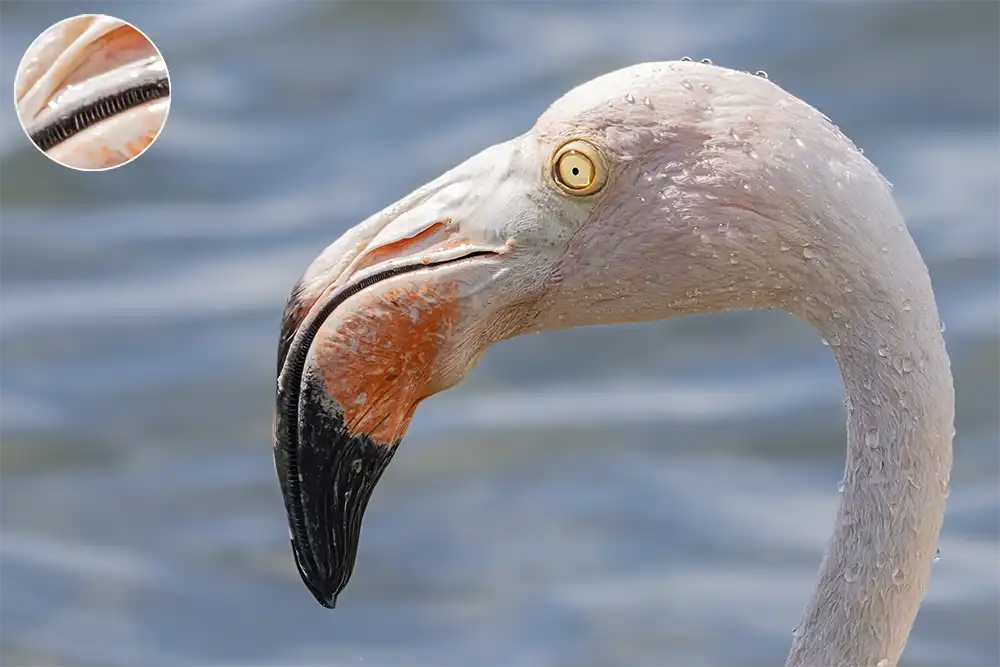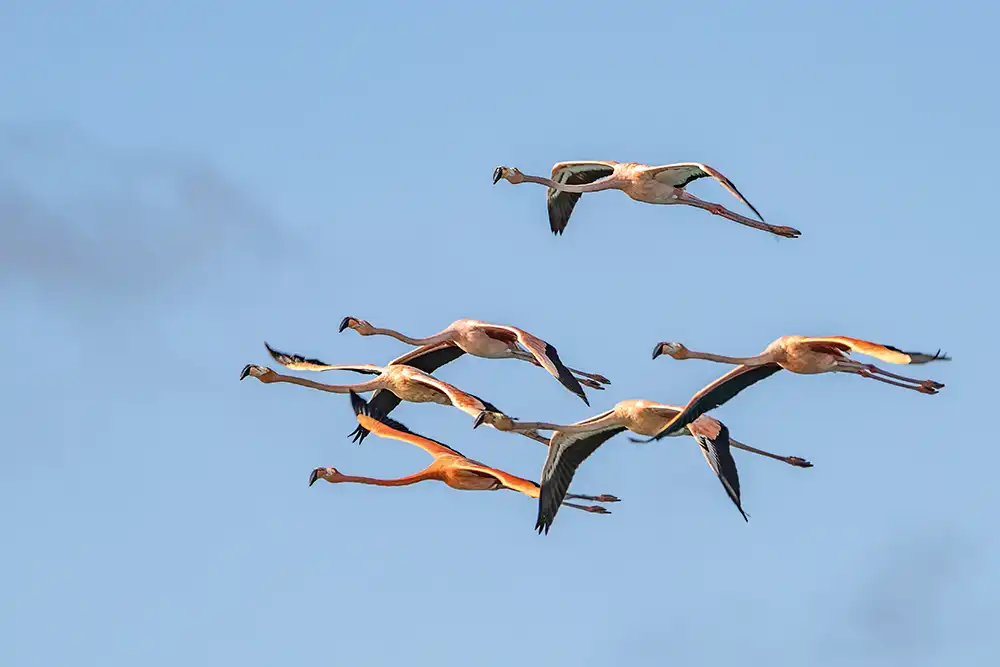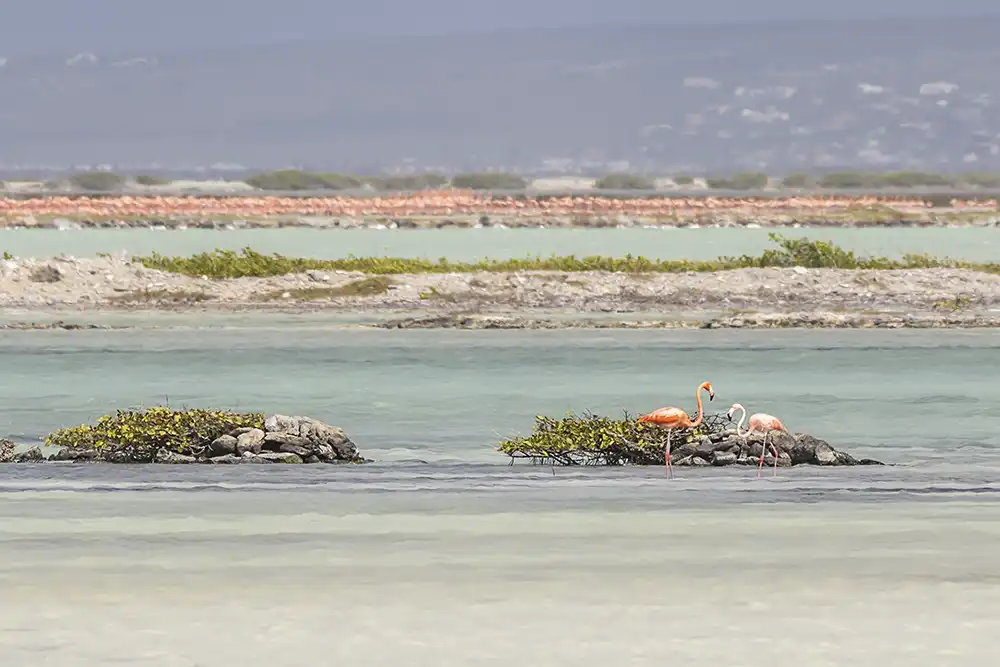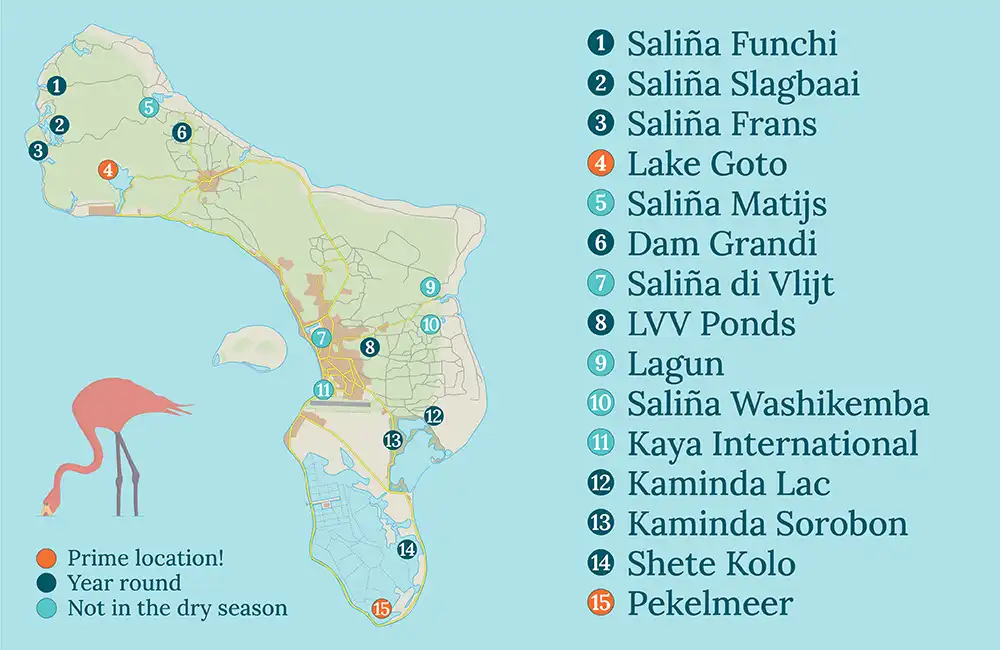Flamingos and Bonaire are inseparably linked. You land at Flamingo Airport, and the flamingo appears everywhere in the streetscape. Watching and photographing these elegant birds is a highlight for many visitors. In this photoblog, we explore the fascinating lives of Bonaire’s flamingos and guide you to the best spots to see and photograph them.
Sharing Island Love
Thank you for your interest in our beautiful island in the Caribbean! We love sharing our passion for Bonaire with everyone — locals, visitors, and of course, with our guests during Our tours. Curious how we do that? You can find all the details in Sharing Island Love.
With Island Love,![]()
Onderwerpen
Text continues below…

Facts and figures
Species: Caribbean flamingo (Phoenicopterus ruber)
Name in Papiamentu: Chogogo
Distribution: Caribbean islands and the (eastern) coasts of Colombia, Venezuela, and Mexico
Lifespan in the wild: Approximately 40 years
Weight: Around 3 kilograms (6 lb.)
Flight speed: 50 to 60 km/h (30 to 35 mph)
Population on Bonaire: Estimates range between 5,000 and 15,000
Call: Resembling that of a goose
Appearance
The Caribbean flamingo has a slender, elongated body. Although flamingos are often referred to as pink, their feathers have an orange hue. Juvenile birds are paler in color. In flight, the black underwings are clearly visible. They have long, thin legs with webbed feet. The neck is long and flexible, and the bill is bright pink with a black tip and a distinctive L-shape.

What do Flamingos eat on Bonaire?
With its long coastline and numerous saliñas, Bonaire is a water-rich island. Flamingos use their specialized beaks to filter food from the water. They are the only birds in the world with a filter-feeding beak.

Inside the flamingo’s beak are hundreds of lamellae. While water, sand, and clay particles pass through, larger particles are retained. Using this mechanism, flamingos filter out fairy shrimp, mosquito larvae, small worms, algae, seeds, and tiny snails. Despite their large size, these birds survive on minuscule food—quite a feat!

Much of their food lives on the bottom. By snapping their beaks into the water, flamingos create small vortexes that stir up bottom-dwelling creatures and algae, which they then filter through their beaks. They also generate these vortexes by rhythmically stepping in place. It’s a surprisingly efficient way for them to gather food.
If the bottom is too deep to reach while standing, flamingos tip forward and start treading water — with only their pink behinds left visible above the surface!

Flamingos are so beautifully pink because their food is rich in carotenoids. This natural pigment also makes carrots orange, for example. The more pigments the birds consume, the stronger their color becomes.

When flamingos cannot find enough food in one area, they travel long distances to food-rich regions. They mainly fly at night. On Bonaire, you can see large groups of flamingos leaving just before sunset, and large groups often arrive just after sunrise. A good place to witness this stunning phenomenon is Pink Beach.

The behavior
Flamingos are social animals that search for food in large groups and breed in colonies. However, this doesn’t mean they always display “socially acceptable” behavior. Within the group, there is a clear hierarchy, and the dominant birds make it known when others are in their way. Often, striking an imposing posture is enough to clear the path. When the tail feathers are raised, things get interesting. A fight may break out, with two or more flamingos attempting to bite each other’s neck or head with sharp strikes. Sometimes, two younger birds even team up to teach a dominant adult a lesson!

The Pekelmeer Flamingo Sanctuary Bonaire
The flamingos on Bonaire are far from shy. You can admire them from close up. We tell you how in a moment. But when it comes to breeding, they do not tolerate any onlookers. Flamingos breed only far away from human activities. In addition, their breeding area must consist of the right type of soil. Flamingos do not build nests out of branches but out of clay. In muddy flats, they carefully sculpt a kind of small mound, on which the egg stays dry during floods. The official breeding season runs from March to July, but the flamingos on Bonaire do not strictly adhere to this.

There are only a few places within the Caribbean flamingo’s range where these two conditions are met. The Pekelmeer Flamingo Sanctuary on Bonaire is one of them. In the natural salt pans in the south of Bonaire, flamingos find both rest and the right substrate.
Nesting flamingos are extremely sensitive to disturbance. Entering the Pekelmeer Flamingo Sanctuary is strictly prohibited. Stay on the paved road!

The breeding colony is located kilometers away from the road and is only visible as an orange stripe in the landscape.
Reproduction
Flamingo reproduction begins with a beautiful ritual. While the birds normally maintain a certain distance from one another, those looking for a partner form a small group. They assume a proud posture, with their heads moving in sync from left to right. After a while, one of them spreads its wings and makes an elegant bow. The others follow this example. Flamingos show interest in each other by walking together. That too happens perfectly in sync!

If the walk goes well, the female offers herself, and mating occurs. In many cases, the pair will maintain a monogamous relationship until the end of the breeding season. Some pairs stay together longer, while other birds switch partners sooner and are often found in the courtship groups.

After mating, the pair builds a nest together from mud, and the female lays one egg. After about 30 days of alternating incubation by the parents, the egg hatches. The white chick breaks the shell with its pointed beak. The parents take turns looking after their little one, but after more than a week, the chick demands so much food that both parents must search for food at the same time. At this point, the chicks gather in groups of hundreds in what are called chick nurseries.

After three months, the chick’s pointed beak has developed into a filter beak, and its downy fluff has been replaced by feathers and flight plumage. The young flamingo can now fly and forage on its own — the parents’ job is done! At this stage, the juvenile is mostly grey rather than pink. It will take another three years before it gains the vibrant color of its parents. Young flamingos are therefore noticeably paler and easy to spot among the adults.

Flamingo in Distress
If you see a flamingo in distress, such as a chick too young to care for itself, please contact the Bonaire Wild Bird Rehab: +5997869292.
Text continues below…

Where to see flamingos on Bonaire?
Lake Goto and the Pekelmeer are two prime locations to see flamingos on Bonaire, but there are many other places where these beautiful birds are regularly spotted. We have marked all the locations where you can spot flamingos on the map. Most locations have flamingos year-round, but during the dry season, the number of spots is smaller.

Tips for viewing flamingos
When visitors see flamingos standing peacefully by the roadside, their first instinct is to get out of the car for the perfect shot. What they forget is that these are wild birds that prefer to keep their distance from humans. The result? All the flamingos walk away, leaving only their pink bottoms in the picture!
The areas where flamingos live are protected. Leaving the public road to photograph them is not only pointless — it’s also strictly forbidden.
That’s why, during our tours, we stay in the car when observing flamingos. We pull over to the side of the road. To enjoy a cooling breeze and the sounds of nature, we open the windows and turn off the engine. This way, the flamingos can carry on undisturbed. They’re wary of people — but not of cars!

Although we usually don’t need binoculars, we always bring them along. This way, you can fully enjoy the extraordinary spectacle. And the photos? We take them for you with our professional camera and telephoto lens!

Photographing Flamingos on Bonaire
The photogenic flamingos of Bonaire always provide exotic shots. But photography is a bit like cooking. By adding special ingredients, you can make the final result more exclusive. Rain, backlighting, or unique interactions, for example, really enhance the atmosphere.

Although flamingos can be photographed well throughout the day, the best photos can be taken around sunrise and sunset. The warm light intensifies the birds’ colors, while the water around them glows in golden hues. In backlight, your subject gets a beautiful silver lining that outlines the distinctive silhouette.

If you want to take your photography to the next level or simply go out with someone whose knowledge of the animals and local conditions increases your chances, book a photography tour with HopiBonaire and go out with a professional nature photographer.

Text continues below…

About us: A tour with HopiBonaire
Spotting flamingos along the side of the road is certainly fun, but these birds are best appreciated in the breathtaking landscapes we find off the beaten path. Of course, we visit Gotomeer and Pekelmeer during our tours, but we also seek out the tranquility of Bonaire’s untouched nature. That’s where you can truly enjoy these and many other extraordinary birds! Your guide will also share fascinating background stories that make the island come to life!

Join us as we visit the island’s hidden gems. HopiBonaire’s tours are intimate experiences. You are out with just your own group, and you set the pace. We don’t watch the clock!
We tailor our tours to your desires. Additionally, you can book fully customized tours, for example, to search for and photograph Bonaire’s flamingos. Have you gotten excited and want to go on an adventure? Check out the variety of our tours!
Read more?












